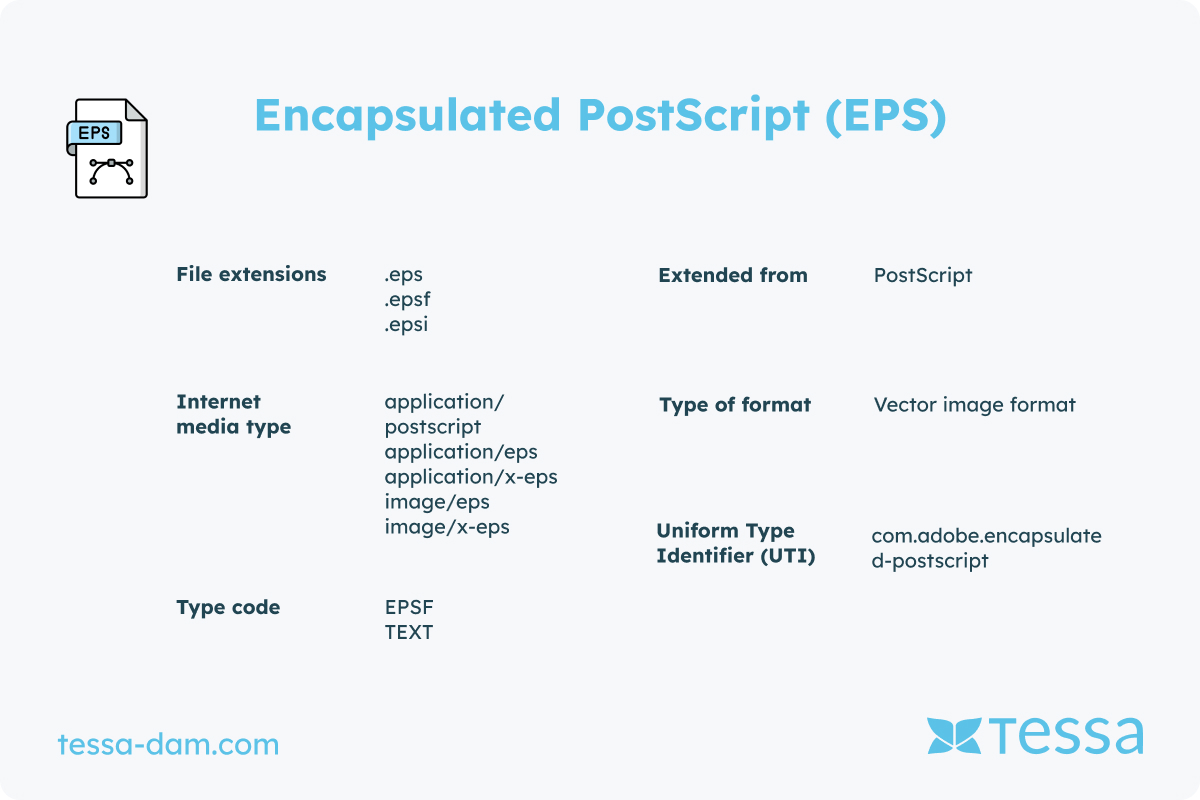Definition
Encapsulated PostScript (EPS) is a graphic format that plays a central role in the digital graphics and printing industry. EPS files are specially designed PostScript files that can contain both vector graphics and raster images. This format was developed to provide a standardized method for transferring and handling graphics between different applications and platforms, which is particularly important in prepress and professional printing.
EPS was developed by Adobe Systems in the 1980s. Adobe, a leading company in the field of graphic and printing software, recognized the need for a flexible and robust format for exchanging graphics. EPS was created to enable the exchange of high-quality graphics between different systems and software applications without losing precision and detail.
Since its introduction, EPS has significantly contributed to efficiency and quality in the graphic and printing industry. The ability to store and transfer graphics in a flexible and standardized format has revolutionized and simplified many workflows. Over the years, EPS has evolved and been integrated into numerous graphic design and printing software, further underscoring its relevance and importance.
What are the Technical Foundations of EPS Files?
Encapsulated PostScript (EPS) is based on the PostScript programming language and acts as a standalone container format that can store both vector graphics and raster images. Technically, an EPS file consists of a well-defined structure that includes header information for identifying and describing the file, as well as PostScript commands for generating the graphic. A key feature of EPS is the ability to include an embedded preview image (usually in TIFF or PICT format), which facilitates handling and display in various applications.
The EPS format allows for high precision in creating complex vector graphics that can be scaled without loss of quality. This makes EPS particularly useful for applications requiring exact reproduction of graphics, such as in prepress and professional printing. Additionally, EPS files can embed bitmap elements in high resolution, allowing for the detailed representation of images.
How Does EPS Compare to Other Graphic Formats?
Compared to other graphic formats, EPS offers specific advantages and disadvantages.
Portable Document Format (PDF) is a widely used format that also supports vector graphics and raster images, but it can additionally include text and interactive elements. PDF is platform-independent and standardized, making it more versatile and user-friendly in many areas, especially for distributing and viewing documents.
Scalable Vector Graphics (SVG) is an XML-based vector format and an open standard by the World Wide Web Consortium (W3C). SVG is particularly popular in web design and interactive applications because it offers flexibility and interactivity. While EPS is proprietary and firmly rooted in the printing industry, SVG shines with its openness and web compatibility.
Portable Network Graphics (PNG) is a raster graphic format known for its lossless compression. Unlike EPS and SVG, PNG cannot store vector graphics and is therefore less suitable for applications requiring scalability. However, PNG is ideal for displaying images with many colors and transparency effects on the web.
Where are EPS Files Used?
EPS has established itself in various fields of the digital graphics and printing industry due to its versatile applications. The ability of EPS to store both vector graphics and raster images makes it a preferred format for numerous uses.
Use in the Printing Industry
EPS is extensively used in prepress and professional printing. Because EPS files allow for precise and high-quality graphics, they are ideal for preparing printed materials. Print service providers appreciate the ability of EPS to scale detailed graphics without loss of quality, which is especially important for producing posters, brochures, and other large-format print products. Additionally, EPS files are platform-independent, facilitating the exchange of print data between different software and hardware solutions.
Use in Digital Graphics
EPS also plays a central role in graphic design. Many professional graphic design programs like Adobe Illustrator and CorelDRAW support EPS and use it for creating and editing vector graphics. Because EPS can contain both vector and raster images, it is a flexible format for working on complex graphic projects. In web design, EPS is less commonly used directly, as formats like SVG and PNG are better suited for web display. However, EPS is often used to create master graphics that are then converted to more web-friendly formats.
Compatibility and Exchange
Another important application area of EPS is the exchange of graphics between different platforms and applications. Due to its widespread support in various graphic design and printing software solutions, EPS serves as a universal exchange format. This facilitates collaboration between designers, printers, and other stakeholders in the production chain. The ability to include an embedded preview image also improves usability and simplifies the identification and editing of graphics in different software environments.
How are EPS Files Created and Edited?
Creating and editing Encapsulated PostScript (EPS) files requires specific tools and techniques to fully exploit the unique advantages of this format. EPS is often used in professional graphic design and printing environments where precision and flexibility are crucial.
Tools und Software
Various software solutions support the creation and editing of EPS files, with some of the most well-known and widely used programs including:
Adobe Illustrator: A leading vector graphic design program that offers comprehensive support for EPS files. It enables the creation, editing, and optimization of vector graphics and exporting them as EPS files.
CorelDRAW: Another powerful vector graphic design program that supports working with EPS files. It offers a variety of tools for creating and editing complex graphics.
Adobe Photoshop: Primarily known for raster graphics, Photoshop also supports opening and editing EPS files, especially when they contain raster images. However, for editing vector graphics in EPS, Photoshop is less suitable than Illustrator or CorelDRAW.
Inkscape: An open-source vector graphic design program that also allows the editing and creation of EPS files. It provides a cost-effective alternative to commercial programs and supports numerous vector and raster graphic formats.
Techniques and Best Practices
When creating and editing EPS files, there are some techniques and best practices to consider for optimal results:
Vectorization of Graphics: Since EPS is mainly used for vector graphics, it is important to vectorize graphics before saving them as EPS. This ensures that the graphics can be scaled without loss of quality.
Embedding Fonts: When creating EPS files, all used fonts should be embedded or converted to outlines. This prevents issues with missing fonts when the file is opened on another system.
Using Layers: Organizing graphics in layers facilitates the editing and management of complex files. Many graphic design programs support working with layers in EPS files.
Optimizing File Size: To optimize the file size of EPS files, unnecessary details should be removed and the resolution of embedded raster images reduced without compromising the quality of the graphic.
Test Printing and Proofing: Before releasing EPS files for printing, a test print should be conducted to ensure all elements are correctly represented. This is especially important for color-critical projects.
Conversion and Export: EPS files can be converted to various formats for use in other applications or for specific purposes. When exporting, the specific requirements of the target medium should be considered.
EPS Graphic Formats and Digital Asset Management (DAM)
EPS plays a crucial role in Digital Asset Management (DAM) systems used for organizing, storing, and managing digital media assets. EPS files are often part of DAM systems because they contain high-quality vector graphics and raster images needed for various applications in the graphics and printing industry.
In a DAM system, integrating EPS files enables efficient management and reuse of graphics. The precise and scalable nature of EPS graphics is particularly advantageous for creating marketing materials, printed matter, and other visual content often required in various sizes and formats. DAM systems offer functions for cataloging, tagging, and searching, which facilitate access to specific EPS files and optimize workflows in creative teams.
Additionally, many DAM systems support the preview and conversion of EPS files to other formats such as PNG, JPEG, or PDF, increasing the flexibility and usability of the stored graphics. This is especially useful for users who may not have direct access to specialized graphic design software but still need high-quality graphics for various purposes.
Using EPS in DAM systems thus contributes to the efficiency and consistency in managing digital assets by providing a central and accessible platform for handling high-quality graphic content.
Conclusion
Versatile format for graphic professionals
EPS is a versatile and powerful graphic format that excels in precisely representing vector and raster graphics. In the printing industry and graphic design, EPS remains indispensable due to its flexibility and quality. Broad support by various software solutions and the ability to exchange graphics across platforms make EPS a valuable tool for professionals. Despite competition from other formats like PDF and SVG, EPS retains its relevance and significance in specialized application areas.





